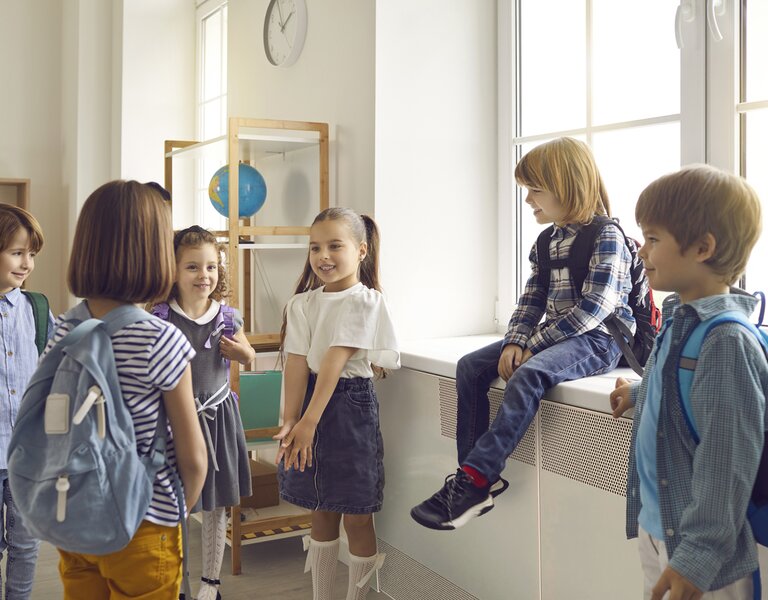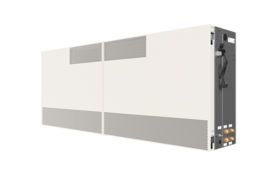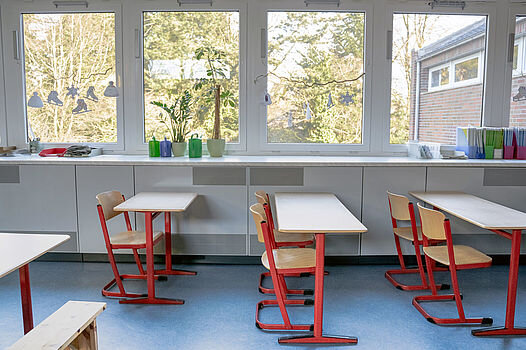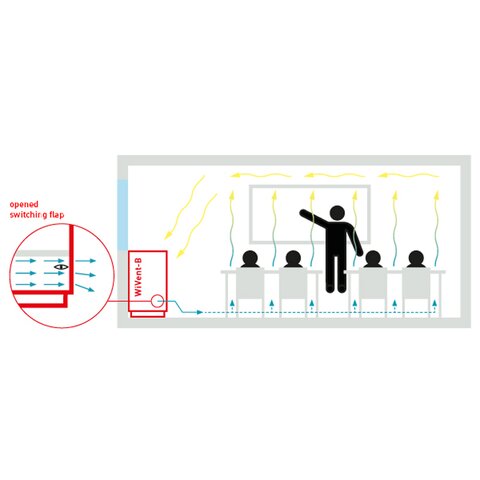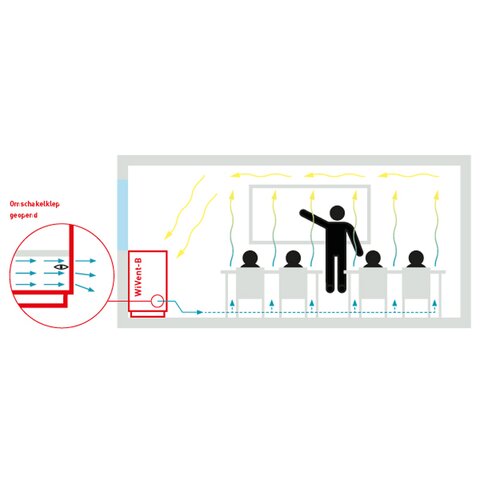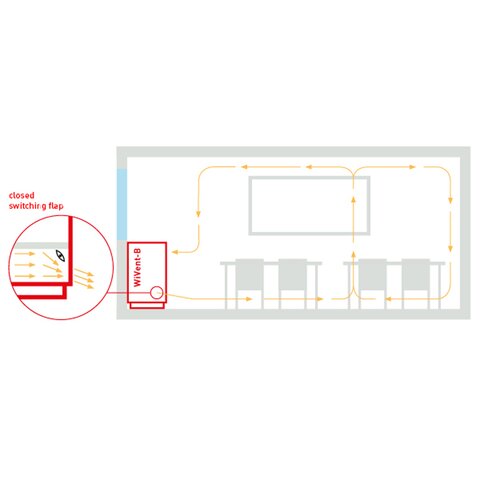The decentralized school ventilation unit WiVent-B provides clean air in classrooms or conference rooms — almost as if you were outdoors. And it doesn't matter whether it's a new building or a renovated one. Sensors measure both the outside and inside temperatures and the CO2 content of the room air, regulating the ventilation system according to demand. Teachers can also adjust the temperature and ventilation intensity of the ventilation units individually using various control devices. The WiVent-B school ventilation unit guarantees high air quality and a pleasant indoor climate in both summer and winter.
The WiVent-B school ventilation unit: the most important facts in brief
At Wildeboer, we offer a range of products for optimizing air distribution in addition to the WiVent-B school ventilation unit. In enclosed spaces such as schools and other educational institutions, it is particularly important to control the supply air and exhaust air in order to ensure good air quality. With our school ventilation unit, you can achieve this and more:
- Individual room ventilation: The WiVent-B school ventilation unit does not feed exhaust air from one room into the supply air of another room.
- Sensors measure both the temperature and the CO2content of the room air and provide the control variables for demand-based ventilation.
- Excellent indoor climate conditions: With the school ventilation unit, you can both heat the rooms – replacing the radiator – and optionally cool them.
- Window ventilation is still possible. The decentralized school ventilation unit switches itself off automatically when the windows are opened by window contacts.
- Excellent hygiene: Our decentralized WiVent-B school ventilation unit is optimized for maintenance with smooth surfaces, making it easy to clean. It has a hygiene certificate issued by an independent institute.
- Low-noise operation: During development, particular emphasis was placed on low-noise operation for an optimal learning environment. Our efficient school ventilation system complies with the required 35 dB (A) in school operations and can be set even quieter if necessary.
- Low operating costs thanks to high energy efficiency and a maintenance-optimized device design
NEW: The GLT interface for our WiVent-B ventilation units makes the management and monitoring of your ventilation systems even more efficient. Easy integration into your building management system allows central control of all devices – either directly on site or conveniently from a remote location.
The BMS interface offers the following functions:
- Integration of ventilation units into the building management system
- Central access to operating modes and room parameters
- Reading of operating states for maintenance purposes
Detailed technical information can be found on the product page of the decentralized WiVent-B ventilation unit.
Our WiVent-B:
Possible uses the WiVent-B school ventilation unit
WiVent-B is suitable for both renovation and new construction projects. The units can be positioned under the window sill and feature a high-quality finish that can be perfectly integrated into individual color schemes for individual classrooms thanks to their availability in all RAL Classic colors. Several units can be combined to form a closed ventilation strip, which is very robust, vandal-proof, and ideally suited for school use. In the case of renovation, radiators can be removed. There are no disruptive installations in the middle of the room or on the ceiling, and the additional space required is very small due to the elimination of radiators. When connected to existing heating pipes, the units take over the heating of the rooms.
The factory-preset control parameters can be easily adjusted to the desired conditions in the room. Many operating modes can be combined via a schedule to suit typical school days and weeks. In addition, all operating modes can be individually adapted to the needs of the users of a classroom. Absence periods, such as school holidays, can also be easily and automatically stored according to state. Despite the automatic control, intervention by the room user is possible via various room control devices.
There are two options for integration into the exterior facade: direct connection of the weather resistant louvre or a cover element to create a rear-ventilated curtain or slat facade to conceal the air diffusers. Both exterior elements are equipped with bird and insect protection and are also available in all RAL Classic colors.
The importance of CO2 concentration for school ventilation units
Fresh air with a low CO2 concentration increases concentration and willingness to learn. That is why it is particularly important in schools that pupils in classrooms are supplied with sufficient fresh air. The WiVent-B school ventilation unit guarantees a stable indoor climate with good air quality for students and teachers in the classroom, even with varying occupancy levels.
Based on the measured CO2 concentration, the air exchange also reduces aerosol concentrations and lowers VOC concentrations. This ensures healthy indoor air quality permanently and completely automatically.
What makes it special: A special switch flap allows the user to switch between a low-turbulence displacement air flow and a high-pulsation mixed air flow as required.
The cooling function of the school ventilation units
The displacement air flow is characterised by a low degree of turbulence and an extremely low impulse. These features guarantee maximum comfort for pupils and teachers and enable increased ventilation effectiveness. The high penetration depth into the classroom is remarkable despite the low impulse. On hot summer days, the cool, fresh air is reliably distributed throughout the classroom.
Reliable even with obstacles
Even in an equipped and occupied classroom, the aim must be to achieve a very good ventilation result. The reliable apprenticeship of a fresh air lake is an important basis for ventilation with displacement air flow. Obstacles such as satchels cannot stop a well realised displacement flow.
Heating capability of decentralised school ventilation units
WiVent-B decentralised school ventilation also ensures a pleasant learning environment in winter. In order to bring supply air into the room during heating, a larger impulse is required due to the higher temperature. This is achieved with the aid of a special changeover damper. This type of flow also ensures that the room is well flushed, so that the classroom reaches a pleasant temperature in a short time.
As a company specialising in building services engineering, e.g. for air distribution, our trained specialists are always available to answer your questions. If you are still unsure about the WiVent-B school ventilation unit or are interested in installing it in your school, we look forward to hearing from you!
Frequently asked questions about our school ventilation units
Thanks to the modular design and intelligent construction, individual assemblies can be removed and maintained easily and without tools. The certified hygiene in ventilation technology and smooth surfaces minimise soilling and make cleaning easy.
Ventilation via the windows is possible at any time. Window contacts can be used for this purpose, which switch off the school ventilation unit as soon as the window is opened. As soon as the window is closed again, ventilation operation restarts automatically.
The installation of a room control unit is not mandatory, but is recommended, as this allows the individual needs of the students and teachers on site to be catered for. It is also possible to make these adjustments via a well-designed web interface.
The control of the decentralised school ventilation units can be adapted to the individual use of the classrooms on a daily basis and to the minute. Seven different operating modes are available for this purpose, which can be assigned to up to twelve time windows. These can also be configured for times when the school is not in use, such as during holidays.
The classrooms or teaching rooms to be ventilated should have a connection to the façade so that outside air and exhaust air can be channelled through. For optimum ventilation of the room, sufficient space should be allowed for the installation and a room depth of eight metres should not be exceeded.
